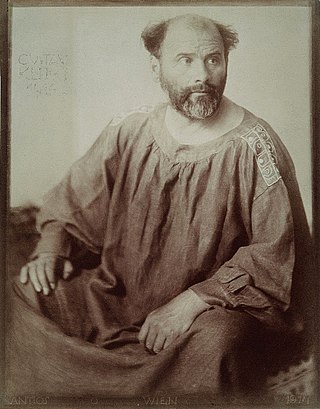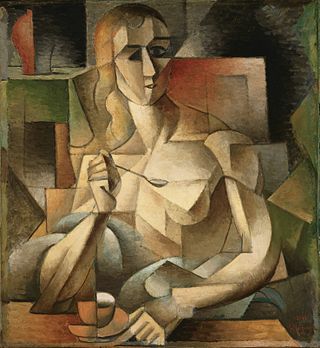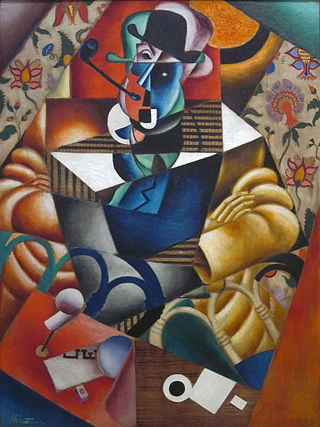
Gustav Klimt was an Austrian symbolist painter and one of the most prominent members of the Vienna Secession movement. Klimt is noted for his paintings, murals, sketches, and other objets d'art. Klimt's primary subject was the female body, and his works are marked by a frank eroticism. Amongst his figurative works, which include allegories and portraits, he painted landscapes. Among the artists of the Vienna Secession, Klimt was the most influenced by Japanese art and its methods.

Cubism is an early-20th-century avant-garde art movement that revolutionized European painting and sculpture, and inspired related artistic movements in music, literature, and architecture. In Cubist works of art, the subjects are analysed, broken up, and reassembled in an abstract form—instead of depicting objects from a single perspective, the artist depicts the subject from multiple perspectives to represent the subject in a greater context. Cubism has been considered the most influential art movement of the 20th century. The term cubism is broadly associated with a variety of artworks produced in Paris or near Paris (Puteaux) during the 1910s and throughout the 1920s.

Jean Dominique Antony Metzinger was a major 20th-century French painter, theorist, writer, critic and poet, who along with Albert Gleizes wrote the first theoretical work on Cubism. His earliest works, from 1900 to 1904, were influenced by the neo-Impressionism of Georges Seurat and Henri-Edmond Cross. Between 1904 and 1907 Metzinger worked in the Divisionist and Fauvist styles with a strong Cézannian component, leading to some of the first proto-Cubist works.

Picasso's Rose Period represents an important epoch in the life and work of the Spanish artist Pablo Picasso which had a great impact on the developments of modern art. It began in 1904 at a time when Picasso settled in Montmartre at the Bateau-Lavoir among bohemian poets and writers. Following Picasso's Blue Period – which depicted themes of poverty, loneliness, and despair in somber, blue tones – Picasso's Rose Period represents more pleasant themes of clowns, harlequins and carnival performers, depicted in cheerful vivid hues of red, orange, pink and earth tones.
Events from the year 1905 in art.

Musée d'Art Moderne de Paris or MAM Paris, is a major municipal museum dedicated to modern and contemporary art of the 20th and 21st centuries, including monumental murals by Raoul Dufy, Gaston Suisse, and Henri Matisse. It is located at 11, Avenue du Président Wilson in the 16th arrondissement of Paris.

Fauvism /ˈfoʊvɪzm̩/ is the style of les Fauves, a group of early 20th-century modern artists whose works emphasized painterly qualities and strong colour over the representational or realistic values retained by Impressionism. While Fauvism as a style began around 1904 and continued beyond 1910, the movement as such lasted only a few years, 1905–1908, and had three exhibitions. The leaders of the movement were André Derain and Henri Matisse.
The Portrait of a Lady is a novel by Henry James.

La Femme au Cheval is a large oil painting created toward the end of 1911, early 1912, by the French artist Jean Metzinger (1883–1956). The work was exhibited in Paris at the Salon des Indépendants in 1912 and the Salon de la Section d'Or, 1912. The following year La Femme au Cheval was reproduced in The Cubist Painters, Aesthetic Meditations by Guillaume Apollinaire (1913).

Le Goûter, also known as Tea Time (Tea-Time), and Femme à la Cuillère is an oil painting created in 1911 by the French artist and theorist Jean Metzinger (1883–1956). It was exhibited in Paris at the Salon d'Automne of 1911, and the Salon de la Section d'Or, 1912.

Portrait of Jacques Nayral is a large oil painting created in 1911 by the French artist, theorist and writer Albert Gleizes (1881–1953). It was exhibited in Paris at the Salon d'Automne of 1911, the Salon de la Section d'Or, 1912, and reproduced in Du "Cubisme" written by Jean Metzinger and Albert Gleizes in 1912, the first and only manifesto on Cubism. Metzinger in 1911 described Gleizes' painting as 'a great portrait'. Portrait of Jacques Nayral, one of Gleizes' first major Cubist works, while still 'readable' in the figurative or representational sense, exemplifies the mobile, dynamic fragmentation of form characteristic of Cubism at the outset of 1911. Highly sophisticated in theory and in practice, this aspect of simultaneity would soon become identified with the practices of the Section d'Or. Here, Gleizes deploys these techniques in a radical, personal and coherent manner.

Man with a Pipe, also referred to as Portrait of an American Smoker, Portrait of an American Smoking, American Smoking and American Man, is a painting by the French Cubist artist Jean Metzinger. The work was reproduced on the cover of catalogue of the Exhibition of Cubist and Futurist Pictures, Boggs & Buhl Department Store, Pittsburgh, forming part of a show in 1913 that traveled to several U.S. cities: Milwaukee, Cleveland, Pittsburgh, New York, and Philadelphia.

La Femme à l'Éventail, or Woman with a Fan, is a painting by the French artist Jean Metzinger. The work was exhibited in 1914 at Moderni Umeni, S.V.U. Mánes, Prague. A 1914 photograph taken at the exhibition in Prague was published in the magazine Zlatá Praha showing Woman with a Fan hanging next to another work by Metzinger known as En Canot , 1913. Donated by Mr and Mrs Sigmund Kunstadter in 1959, Woman with a Fan forms part of the permanent collection in Gallery 391B at the Art Institute of Chicago, US.

Baigneuses, also called Bathers, is a Proto-Cubist painting, now lost or missing, created circa 1908 by the French artist and theorist Jean Metzinger. Possibly exhibited during the spring of 1908 at the Salon des Indépendants. This black-and-white image of Metzinger's painting, the only known photograph of the work, was reproduced in Gelett Burgess, "The Wild Men of Paris", Architectural Record, May 1910. The painting was also reproduced in The New York Times, 8 October 1911, in an article titled "The 'Cubists' Dominate Paris' Fall Salon", and subtitled, "Eccentric School of Painting Increases Its Vogue in the Current Art Exhibition - What Its Followers Attempt to Do".

Femme au Chapeau or Lucie au chapeau is an oil painting created circa 1906 by the French artist and theorist Jean Metzinger (1883–1956). The work is executed in a highly personal Divisionist style with a marked Proto-Cubist component during the height of Fauvism. Femme au Chapeau exhibits a presentiment of Metzinger's subsequent interest in the faceting of form associated with Cubism. The painting now forms part of the collection of the Korban Art Foundation.

Femme à l'Éventail is an oil painting created in 1912 by the French artist and theorist Jean Metzinger (1883–1956). The painting was exhibited at the Salon d'Automne, 1912, Paris, and De Moderne Kunstkring, 1912, Amsterdam. It was also exhibited at the Musée Rath, Geneva, Exposition de cubistes français et d'un groupe d'artistes indépendants, 3–15 June 1913. A 1912 photograph of Femme à l'Éventail hanging on a wall inside the Salon Bourgeois was published in The Sun, 10 November 1912. The same photograph was reproduced in The Literary Digest, 30 November 1912.

Le Fumeur, or Man with Pipe, is a Cubist painting by the French artist Jean Metzinger. It has been suggested that the sitter depicted in the painting represents either Guillaume Apollinaire or Max Jacob. The work was exhibited in the spring of 1914 at the Salon des Indépendants, Paris, Champ-de-Mars, March 1–April 30, 1914, no. 2289, Room 11. A photograph of Le Fumeur was published in Le Petit Comtois, 13 March 1914, for the occasion of the exhibition. In July 1914 the painting was exhibited in Berlin at Herwarth Walden’s Galerie Der Sturm, with works by Albert Gleizes, Raymond Duchamp-Villon and Jacques Villon.

Les Peintres Cubistes, Méditations Esthétiques, is a book written by Guillaume Apollinaire between 1905 and 1912, published in 1913. This was the third major text on Cubism; following Du "Cubisme" by Albert Gleizes and Jean Metzinger (1912); and André Salmon, Histoire anecdotique du cubisme (1912).

Femme au miroir, Femme à sa toilette or Lady at her Dressing Table, is a painting by the French artist Jean Metzinger. This distilled synthetic form of Cubism exemplifies Metzinger's continued interest, in 1916, towards less surface activity, with a strong emphasis on larger, flatter, overlapping abstract planes. The manifest primacy of the underlying geometric configuration, rooted in the abstract, controls nearly every element of the composition. The role of color remains primordial, but is now restrained within sharp delineated boundaries in comparison with several earlier works. The work of Juan Gris from the summer of 1916 to late 1918 bears much in common with that of Metzinger's late 1915 – early 1916 paintings.

Crystal Cubism is a distilled form of Cubism consistent with a shift, between 1915 and 1916, towards a strong emphasis on flat surface activity and large overlapping geometric planes. The primacy of the underlying geometric structure, rooted in the abstract, controls practically all of the elements of the artwork.

















